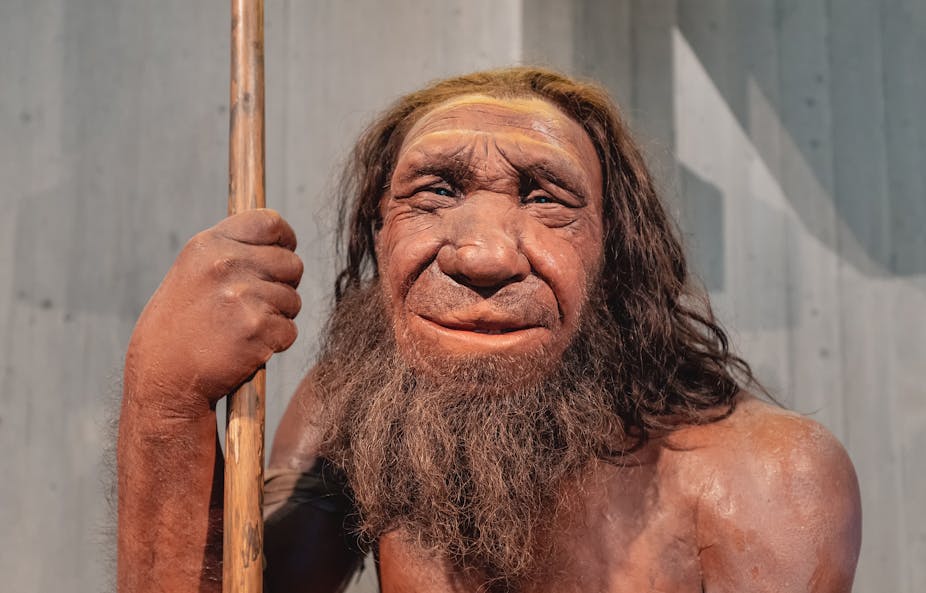For generations, Neanderthals have been a source of fascination for scientists. This species of ancient hominim inhabited the world for around 500,000 years until they suddenly disappeared around 40,000 years ago. Today, the cause of their extinction remains a mystery.
Archaeologist Ludovic Slimak and his team have spent three decades excavating caves, studying ancient artefacts and delving into the world of Neanderthals – and they’ve recently published provocative new findings. In this week’s episode of The Conversation Weekly podcast, we speak to Slimak about how Neanderthals lived, what happened to them, and why their extinction might hold profound insights into the story of our own species, Homo Sapiens.
Neanderthals migrated to Europe around 400,000 years ago from Africa, the birthplace of humanity. Until now, the general consensus among archaeologists has been that Homo Sapiens were a lot slower to leave Africa, only migrating to Europe approximately 42,000 years ago and in one wave that coincided with the extinction of Neanderthals.
But Slimak, an archaeologist at Université Toulouse III - Paul Sabatier in France, has published controversial new work that challenges this.
In 2022, he published research from the Mandrin Grotte in the Rhône valley in southern France, which suggested he’d found a Homo Sapiens tooth within Neanderthal sediment layers. He explains:
We began to work in the middle of these layers that were dated at 54,000 years, and then we began to find incredibly modern Homo Sapiens technologies sandwiched between very classic Neanderthal technologies.
Slimak’s subsequent research suggests that, rather than a single wave of Homo Sapiens migration from west Asia to Europe, there were in fact three waves, the last of which happened around 42,000 years ago. These findings are provocative: they would rewrite the timeline to suggest that Homo Sapiens arrived in Europe about 10,000 years earlier than previously thought, and so co-existed with Neanderthals for much longer.
Read more: The earliest modern humans in Europe mastered bow-and-arrow technology 54,000 years ago
What tools reveal
To understand the factors that led to the extinction of Neanderthals and the survival and dominance of Homo Sapiens, Slimak has also compared the tools crafted by both species during the period they co-inhabited Europe. His hypothesis is that examining the evolution of these tools and how they’re made might provide clues into the differing fates of the two human species.
During a three-year study, he compared flint tools found in Lebanon’s Ksar ‘Akil cave to those in France. Slimak noticed a striking similarity in the flint points atop spears crafted by Homo Sapiens, even those produced tens of thousands of years apart. He explains:
If you take Homo Sapiens tools or weapons technology, after you’ve seen a hundred of these tools, they are precisely the same. So, we have a process of standardisation, of production in series that is very specific to our species. But now, if you take Neanderthal tools … each of them will be different from the others. That is systematic among all Neanderthal societies.
Slimak argues that Homo Sapiens’ disposition for systematisation and standardisation might have conferred an evolutionary advantage during that period. It wasn’t a matter of Homo Sapiens wiping out other human species such as Neanderthals. Rather, their efficient ways may have played an pivotal role in their survival.
To find out more, listen to the full episode of The Conversation Weekly podcast. A transcript of this episode is now available.
This episode was written and produced by Mend Mariwany, with assistance from Katie Flood. Eloise Stevens does our sound design, and our theme music is by Neeta Sarl. Gemma Ware is the executive producer of the show.
You can find us on Twitter @TC_Audio, on Instagram at theconversationdotcom or via email. You can also subscribe to The Conversation’s free daily email here.
Listen to The Conversation Weekly via any of the apps listed above, download it directly via our RSS feed or find out how else to listen here.

